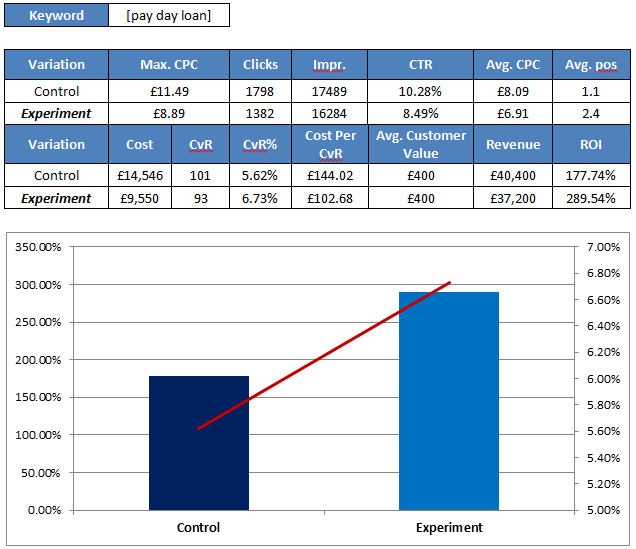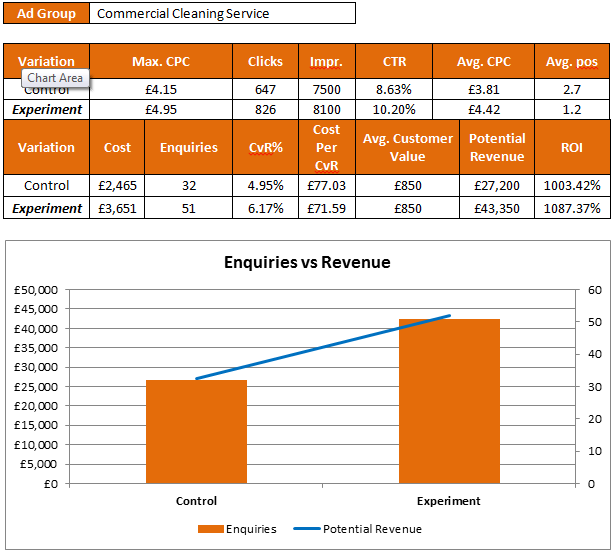 When running a paid search campaign it’s important to identify the clear objectives of the business from the outset. These should be reflected in the strategy and any relevant KPIs that are agreed upon, whether it be a target ROI, lead volume, conversion rate (CvR%) or cost-per-acquisition (CPA). These are the key metrics by which performance is measured, so any tools that can help improve them are always useful. To that end, Google’s Adwords Campaign Experiments (ACE) is certainly a valuable feature that is often under-utilised.
When running a paid search campaign it’s important to identify the clear objectives of the business from the outset. These should be reflected in the strategy and any relevant KPIs that are agreed upon, whether it be a target ROI, lead volume, conversion rate (CvR%) or cost-per-acquisition (CPA). These are the key metrics by which performance is measured, so any tools that can help improve them are always useful. To that end, Google’s Adwords Campaign Experiments (ACE) is certainly a valuable feature that is often under-utilised.
ACE allows you to test changes to different areas of your Adwords account by classifying a control and variation and then splitting your traffic between the two. You must dictate what percentage of your auctions the experiment will impact and how long it will run for, then you define what change you want to test. Various elements can be changed across ad groups, keywords and bids, however this piece will focus purely on the use of bid experiments to trial different approaches to bidding aggression.
There are a number of reasons why one might want to experiment with bids on an account, with the following being some of the most likely:
- Discovering the difference in the cost of clicks between positions
- Working out how CTR varies across different positions
- Understanding the effect of different positions on conversion rate
- Testing how ad positions impact conversion quality (e.g. better leads or higher order values).
Ultimately, by using a combination of bidding tests, it allows you to see the impact on ROI and profit.
The two hypothetical scenarios below attempt to provide some context to illustrate where bid testing could be appropriate.
Scenario 1
- A payday loans provider operating in a very competitive market
- PPC bid prices are at a premium
- Their main focus is increasing profitability and ROI.
Here, it could be beneficial to use a bid experiment on one of the main keywords to test whether a better ROI can be achieved by bidding less aggressively. The potential results of a less aggressive bid experiment are illustrated below, using payday loans as an example:
We can see in the example here that as a result of bidding less aggressively on a primary keyword in the account and appearing in a slightly lower average position, the average CPC has been reduced by 19%, improving ROI from 175% to 254%. Bidding less aggressively on this particular term would therefore appear to be a viable bidding strategy in this scenario as maximising ROI is one of the core business objectives.
Scenario 2
o A B2B commercial cleaning service whose business model is based on increasing its customer base
o They also have a focus on maintaining a high level of customer retention to capitalise on the lifetime value of a customer.
In this case, it could be worthwhile to experiment with a more aggressive bidding strategy across one of the core ad groups to see the impact on lead volume. Some illustrative results to a potential bid experiment are provided below, where bidding aggression has been increased for keywords within a given ad group, using the commercial cleaning example:
The above results show that as a result of increasing the max. CPC in the ad group, the average ad position has improved from 3.2 to 1.1. Whilst the increased click price has increased cost, this is fairly insignificant when compared to the uplift in potential revenue. Cost has gone up by £786, whereas potential revenue has increased by £5,100 from the 6 additional customers generated as a direct result of occupying higher positions.
Obviously the results of bid experiments are likely to vary across different industries/sectors, as is illustrated in the above scenarios.
The Pay Day Loans results would indicate that bidding more aggressively and improving ad position appears to be worthwhile. An explanation for this could be that customers looking for short term loan solutions are perhaps more desperate, less price sensitive and research focused, so a more prominent position generates more leads. Conversely in the Commercial Cleaning example, the conclusion you would draw from the results is that people appear to be more price sensitive, shopping around for prices before committing. As such, a lower ad position actually yields better results when educated leads come back and convert, following the research stage.
If used correctly and monitored closely, ACE can certainly be valuable in testing how changing variables can impact PPC performance, however there are a few points that are useful to take into account when creating experiments:
o Try to test areas of significance, i.e. things that will impact key metrics that directly contribute to the business goals/objectives
o Make sure you test your experiment over a reasonable time period (e.g.2-4 weeks) so that any decisions or outcomes are based on a decent amount of data
o Think carefully about the percentage of traffic that you want to dedicate to your experiment variation and to monitor your tests closely, particularly if you are testing a high volume keyword.
Finally, remember that if you launch an unsuccessful experiment that affects a large proportion of traffic, this can have a detrimental impact on the overall performance of the account, so make sure you keep an eye on them!
Click here for more information on how to set up Google’s Adwords Campaign Experiments.




